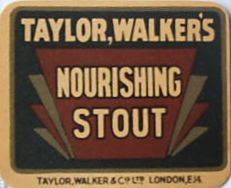London was unusual in that Stout remained a standard draught beer throughout the interwar period. Most brewers decided to make their draught Stout an 8d per pint beer. Though a few plumped for a 7d beer and some made both a 7d and an 8d one. The last was a dangerous practice. From the gravity books I can see that some unscrupulous landlords were either watering their Stout or selling the 7d version for 8d.
The beers fit very neatly into the gravity bands defines in the last set of WW I price controls. Where an 8d beer was 0ver 1054º and 7d 1046º-1053º. It's incredible how these definitions of strength/price remained in place right through until WW II.
For a style of beer which was intended to be full-bodied, the average rate of attenuation is pretty decent, being around 72% for both types.
Next we'll be looking at a few of these Stouts in greater detail. Won't that be fun?
| Between the wars draught London Stout | ||||||
| Year | Brewer | Price per pint (d) | OG | FG | ABV | App. Atten-uation |
| 1928 | Courage | 7 | 1048 | 1014 | 4.41 | 70.83% |
| 1928 | Hoare | 7 | 1046.6 | 1013.6 | 4.28 | 70.82% |
| 1931 | Taylor Walker | 7 | 1049 | 1013 | 4.67 | 73.47% |
| 1926 | Truman | 7 | 1046.3 | |||
| 1928 | Wenlock | 7 | 1042.9 | 1011.8 | 4.03 | 72.49% |
| Average | 1046.6 | 1013.1 | 4.35 | 71.90% | ||
| 1928 | Barclay Perkins | 8 | 1054.9 | 1017.2 | 4.89 | 68.67% |
| 1926 | Cannon | 8 | 1057.9 | |||
| 1930 | Charrington | 8 | 1055.2 | |||
| 1929 | Hoare | 8 | 1056.2 | 1018 | 4.95 | 67.97% |
| 1926 | Huggins | 8 | 1055.5 | |||
| 1927 | Mann Crossman | 8 | 1056.6 | |||
| 1931 | Meux | 8 | 1051 | 1014.7 | 4.71 | 71.18% |
| 1931 | Taylor Walker | 8 | 1055.3 | 1015.9 | 5.11 | 71.25% |
| 1929 | Truman | 8 | 1058 | 1011.3 | 6.09 | 80.52% |
| 1929 | Watney | 8 | 1055.9 | 1014.5 | 5.38 | 74.06% |
| 1926 | Whitbread | 8 | 1058.7 | |||
| 1931 | Wenlock | 8 | 1046.6 | 1012.3 | 4.45 | 73.61% |
| Average | 1055.2 | 1014.8 | 5.08 | 72.23% | ||
| Sources: | ||||||
| Truman Gravity Book held at the London Metropolitan Archives, document number B/THB/C/252. | ||||||
| Whitbread Gravity book held at the London Metropolitan Archives, document number LMA/4453/D/02/001. | ||||||

By 1946, Orwell was opining in The Moon Under Water that "I doubt whether as many as 10 per cent of London pubs serve draught stout".
ReplyDeleteThe beers fit very neatly into the gravity bands defines in the last set of WW I price controls. Where an 8d beer was 0ver 1054º and 7d 1046º-1053º. It's incredible how these definitions of strength/price remained in place right through until WW II.
ReplyDeleteSo is that - the WWI price controls and 20-25 years of stability afterwards - where we get references to low-end 4d (mild) ale and the public bar as the "four-ale bar" (meaning fourpenny-ale)?
Phil,
ReplyDeletefour ale bar comes from before WW I and refers to the price per quart of standard Mild Ale.